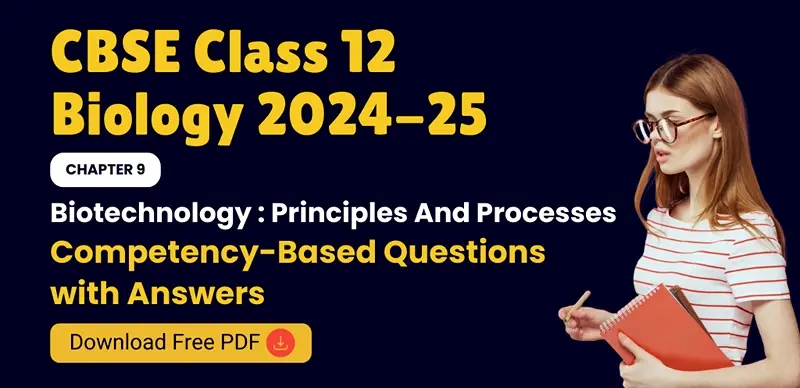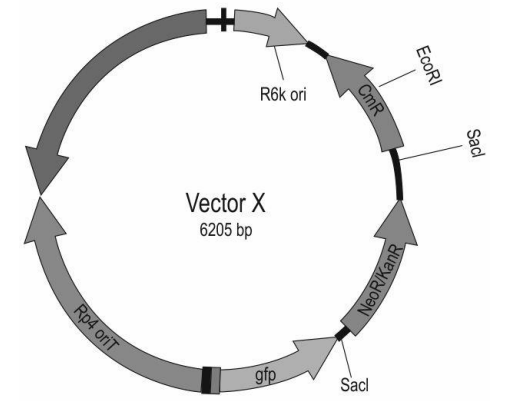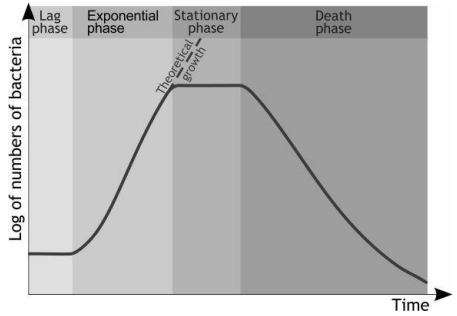CBSE Class 12 Biology 2024-25: Chapter 9 Biotechnology : Principles And Processes Competency-Based Questions with Answers; Download Free PDF

SHARING IS CARING
If our Website helped you a little, then kindly spread our voice using Social Networks. Spread our word to your readers, friends, teachers, students & all those close ones who deserve to know what you know now.
Get ready for your CBSE Class 12 Biology exams with our easy guide on Chapter 9: Biotechnology : Principles And Processes. This chapter is very important, especially with the new exam pattern starting in the 2024-25 school year. The CBSE will include 50% more competency-based questions. These questions ask you to use what you've learned in real-life situations.
In this article, we focus on key questions from Chapter 9: Biotechnology : Principles And Processes. These questions help you think and solve problems. You’ll find different types of questions, such as multiple-choice, true-false, gap-filling, and short-answer questions. Each question has clear answers to help you understand the concepts better.
To help you study, you can download a free PDF that has all the competency-based questions from Chapter 9: Biotechnology : Principles And Processes along with their answer keys.
CBSE 12 Biology Chapter 9 : Biotechnology : Principles And Processes Competency-Based Questions
Q.1 Nihal said that bacteria are never used as a host to clone recombinant DNA for antibiotic production. Is his statement correct and why?
A. Yes, because antibiotics kill host bacterial cells.
B. No, because antibiotics only kill cells other than bacterial cells.
C. No, because the foreign DNA or the host bacterial cell is resistant to the antibiotic being produced.
D. Yes, because host bacterial cells do not have the machinery to allow the growth of an antibiotic obtained from other microbes.
Answer. D. Yes, because host bacterial cells do not have the machinery to allow the growth of an antibiotic obtained from other microbes.
Q.2 A researcher used a vector X to insert a foreign gene to create a recombinant vector. The image of vector X is shown below.

It has sites for two restriction enzymes - SacI and EcoRI. The foreign gene can be cut using either of these two enzymes. The vector also has a green fluorescent protein (gfp) gene that can be used as a selectable marker, and two genes - chloramphenicol resistance (CmR) and neomycin resistance (NeoR) that provide antibiotic resistance. Chloramphenicol and neomycin are two different antibiotics.
(a) What is/are the possible end product(s) that will be obtained post-ligation if the researcher uses the following enzyme to insert the foreign gene:
(i) SacI
(ii) EcoRI
(b) Based on (a), which enzyme will be better to use to ensure that the foreign gene has been inserted in the vector? Why?
(c) If the well of an agarose gel is filled with a solution of the intact vector and the foreign gene, what will the DNA band closer to the well contain? Why?
Answer. (a) 0.5 marks each for the following:
(i) [2 marks]
- self-ligated vectors/vectors without the foreign gene inserted - vectors with the foreign gene ligated at any of the two positions
- self-ligated vectors without the foreign gene and the neoR gene
- self-ligated vectors with the foreign gene but without the neoR gene
(ii) [1 mark]
- self-ligated vectors/vectors without the foreign gene inserted
- vectors with the foreign gene inserted inside the CmR gene.
[Award marks if the end products are drawn]
(b) 0.5 marks each for the following:
- EcoRI is a better enzyme to use.
- Use of EcoRI will ensure the foreign gene insertion because apart from the presence of gfp, it will also be susceptible to chloramphenicol. So only colonies that do not grow on the chloramphenicol-containing medium will have the foreign gene inserted.
(c) 0.5 marks each for the following:
- intact vector
- DNA fragments in an agarose gel move depending on their size where larger fragments stay close to the well while smaller fragments move further away.
[Accept any other valid answer]
Q.3 The large-scale production of an organism is generally done in a bio-processor unit. Given below is the growth curve of a bacteria that is being used for the production of a recombinant molecule. Maintaining sterile conditions is of utmost importance in a bio-processor unit.

(a) In which phase are the cells likely to be producing a larger concentration of the recombinant molecule? Why?
(b) In cases where the culture in the bio-processor unit reaches the death phase, identify ONE strategy that can help revive the bio-processing to restart production of the recombinant molecule.
(c) What does a sterile condition mean?
(d) State ONE reason why the bacteria that are producing the recombinant molecule are not harmed during the process of sterilisation.
Answer. (a) 1 mark each for the following:
- exponential growth phase
- that is the phase where biomass is highest and so each cell produces the recombinant molecule causing its overall concentration to be the highest in the unit
(b) 1 mark for any ONE of the following:
- addition of more microbes in the growth phase
- adding fresh medium while removing the used-up medium
[Accept any other valid answer]
(c) A sterile condition refers to the absence of contaminating organisms in a system.
[Accept any other valid answer]
(d) 1 mark for any one of the following:
- bacterial culture of interest is added after the sterilisation process
- if the bacteria of interest is thermophilic/die at higher temperature than that used for sterilisation
[Accept any other valid answer]
Q.4 Bacterial cells offer certain advantages over plant or animal cells that make them an easy choice for the production of many recombinant molecules. State THREE such advantages.
Answer. 1 mark each for the following:
- Bacterial cells replicate much faster than plant or animal cells.
- Bacterial cells naturally possess extrachromosomal DNA which can act as carriers for the recombinant DNA.
- Absence of the nuclear membrane in bacterial cells makes it easy to introduce the recombinant plasmid to the replication, transcription and translation machinery of the cell.
[Accept any other valid answers]
Q.5 Give TWO reasons why it is important to introduce the gene/s of interest in a vector and then into the host cell or insert it directly into the host chromosomal genome.
Answer. 1 mark each for the following:
- An alien piece of DNA in the cytoplasm is likely to get degraded.
- A piece of DNA will not get replicated without the origin of replication and so will not get inherited.
| Download PDF | |
| CBSE Class 12 Biology Chapter 1 Sexual Reproduction in Flowering Plants: Important Competency-Based Questions 2024-25 | Click Here |
| CBSE Class 12 Biology Chapter 2 Human Reproduction: Important Competency-Based Questions 2024-25 | Click Here |
| CBSE Class 12 Biology Chapter 3 Reproductive Health: Important Competency-Based Questions 2024-25 | Click Here |
| CBSE Class 12 Biology Chapter 4 Principles Of Inheritance And Variation: Important Competency-Based Questions 2024-25 | Click Here |
| CBSE Class 12 Biology Chapter 5 Molecular Basis Of Inheritance: Important Competency-Based Questions 2024-25 | Click Here |
| CBSE Class 12 Biology Chapter 6 Evolution: Important Competency-Based Questions 2024-25 | Click Here |
| CBSE Class 12 Biology Chapter 7 Human Health And Disease: Important Competency-Based Questions 2024-25 | Click Here |
| CBSE Class 12 Biology Chapter 8 Microbes In Human Welfare: Important Competency-Based Questions 2024-25 | Click Here |
| CBSE Class 12 Biology Chapter 9 Biotechnology : Principles And Processes: Important Competency-Based Questions 2024-25 | Click Here |
Q.6 pBR322 was a plasmid that was constructed artificially using genetic material from three sources:
i) the tetracycline resistance gene of pSC101
ii) the ampicillin resistance gene of RSF 2124
iii) the replication elements of pMB1, a close relative of the ColE1 plasmid. Describe the TWO enzymatic steps that would have occurred in the construction of pBR322.
Answer. 1 mark each for the following:
- The DNA sequences coding for the antibiotic resistance genes and the replication elements would have been cut from the original plasmid using appropriate restriction enzymes.
- The fragments created after restriction digestion would need to be ligated using DNA ligase to construct the vector.
Q.7 In the process of DNA replication, RNA primers are used to initiate replication where a free nucleotide can start forming a bond with the RNA primer as per the leading strand base sequence. Later, this RNA primer needs to be removed.
What type of a nuclease can help with this activity? Why?
Answer. 1 mark each for the following:
- exonuclease
- Since the nucleotides from the end of the DNA strand need to be removed exonucleases can help with the activity.
[Accept any other valid answer]
Q.8 The basis of rDNA technology is to alter the genetic material of an organism to obtain enhanced and desired characteristics in an organism.
(a) Preferably, the gene of interest and the vector are cut with the same restriction enzyme. Is this statement true? Give a reason to support your answer.
(b) What is/are ALL the possible outcomes after the gene of interest and the vectors are ligated?
(c) If a vector contains an ampicillin resistance gene as the selectable marker, state TWO situations in which the host cell will grow in a medium that contains ampicillin.
Answer. (a) - True [0.5 marks]
- If the gene of interest and vector are cut with the same restriction enzyme they will produce the same sticky ends that are complementary to each other, making ligation easier. [1 mark]
(b) 0.5 marks for each of the following:
- self-ligated vector/s
- two of more genes of interest self-ligate
- gene of interest and vector ligate
(c) 1 mark each for the following:
- If the gene of interest ligates into the vector and gets transformed into the host cell.
- If the vector self-ligates and gets transformed into the host cell.
Q.9 State whether each of these statements given below is/are true or false. Justify your answer.
(a) Plasmids with a single restriction site are preferred over those with multiple sites for the same enzyme during the cloning process.
(b) The tumour-inducing (Ti) plasmid can be extracted from Agrobacterium tumifaciens cells and used as it is for cloning a foreign gene
Answer. (a)
- True [0.5 marks]
- Plasmids with a single restriction site get cut at only one site increasing the possibility of obtaining a cloned vector rather than those with multiple cleaving sites for the same enzyme. [1 mark]
[Accept any other valid answer]
(b)
- False [0.5 marks]
- Plasmids extracted from the bacteria cannot be used as it is as the pathogenic genes need to be removed before it can be used as a vector. [1 mark]
[Accept any other valid answer]
Q.10 Vectors containing the foreign DNA have to be forced into host cells that are made competent to do so. A common method is to first treat host cells with calcium chloride and then incubate these cells on ice. This is followed by briefly placing them at 42 °C and then putting them back on ice. This enables the host cells to take up recombinant DNA and is called the heat shock treatment.
(a) Explain why DNA vectors CANNOT pass through the cell membrane like other molecules such as oxygen.
(b) Calcium from a CaCl2 solution binds to DNA making it easier for them to enter a cell. Why?
(c) Why does the heat shock treatment make the membrane porous allowing for easy uptake of DNA?
Answer. (a) 1 mark each for the following:
- The cell membrane is an amphipathic structure whose outer ends are hydrophobic or non-polar in nature.
- Oxygen being a non-polar molecule can enter the cell easily but DNA is highly polar/hydrophilic in nature which is repelled by the cell membrane.
[Accept any other valid answer. Marks to be awarded to mentioning the highlighted points.]
(b) 1 mark each for the following:
- DNA is a negatively charged molecule and this makes it highly polar in nature.
- Calcium are divalent cations which bind to DNA making it non-polar and so easier to cross the cell membrane.
[Accept any other valid answer.]
(c) An increase in temperature results in greater kinetic energy of molecules making the membrane more fluid/porous.
Q.11 Polymerase chain reaction (PCR) is an in-vitro technique used to amplify nucleic acid sequences. The conditions and duration of each step in PCR are as follows:
- Step 1 at 94 °C for 2 min
- Step 2 at 50-65 °C for 30 seconds
- Step 3 at 72 °C for 5 min
(a) Give TWO reasons why amplification using PCR can be better than amplification in-vivo using plasmids.
(b) At which step does the denaturation of DNA take place? How does this occur?
(c) What would be the result of the PCR reaction if step 2 does not occur?
(d) At what step would PCR be important in rDNA technology?
Answer. (a) 1 mark each for the following:
- PCR is faster than the generation time of many microbes.
- An origin of replication is not required for PCR as is required in plasmids.
[Accept any other valid answer] (b) 0.5 marks each for the following:
- Step 1
- Heat causes denaturation of DNA.
(c) No DNA would be amplified OR the reaction would stop.
(d) PCR would be an important step just before the process of ligation, done before transformation into the required host.
Q.12 Insulin is commonly prepared in bio-processing units for patients suffering from insulin-dependent diabetes.
Explain THREE steps that would be a part of the downstream processing for insulin.
Answer. 1 mark for each of the following:
- The first step would be extraction of the protein from the cells in which it is produced.
- The second step would be to purify only insulin from the other cell contents that would get mixed in the process of extraction.
- The third step would be to store insulin at low temperatures to prevent denaturation of the hormone.
[Accept any other valid answer]
-
👉 Read Also - CBSE Class 12 Half-Yearly/Mid Term 2024-25 : Most Important Questions with Answers; PDF Download (All Subjects)
👉 Read Also - How CBSE’s New Exam Pattern Will Impact Class 11 and 12 Students
👉 CBSE Class 12 Study Materials
| CBSE Class 12 Syllabus 2024-25 | CBSE Class 12 Previous Year Papers |
| NCERT Books For Class 12 Books | NCERT Class 12 Solutions |
| CBSE Class 12 Full Study Material | CBSE Class 12 Sample Paper 2024-25 |







 Profile
Profile Signout
Signout












 Quiz
Quiz
 Get latest Exam Updates
Get latest Exam Updates 










